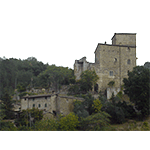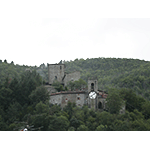Castello di San Niccolò [Castle of San Niccolò]
Though the first news that explicitly cites the Castle of San Niccolò dates only to 1253, it is very likely that the hill with today’s remains of the ancient thirteenth-century castle was the location of a fortified site much earlier. The castrum, as of the 11th century property of the Guidi Counts, became property of the Republic of Florence in 1349. Since then one of the main castles of Casentino and for its fortified position, it was chosen as the Podesteria (office held by the Podestà, the head of civic government in medieval Italy) of the Florentine Mountain. Renovated as of the 1970s by its owner Giovanni Biondi, the complex conserves part of the outer circle of walls, the original entry gate, and one of the powerful towers that marked its perimeter. A large portion of the thirteenth-century keep also survives and develops around a small porticoed courtyard. The rooms here, which once housed the prison and the court-house of the Florentine Podesteria, today exhibit a collection of equipment tied to the farming world, in addition to objects of everyday use such as ceramics of the medieval and Renaissance ages, interesting tools for spinning and antique furnishings. The portico of the keep is also the location of the clockwork that was originally on the tower at the entrance to town and is equipped with two circular quadrants in masonry with Roman numerals (6 figures), datable between 1806 and 1807, and today activated by an electronic device. The old mechanism created by Ferdinando Bagnoli in substitution of the previous, Flemish-made clock of 1570, instead dates to 1863.
****************************
Texts by Elena Fani
English translation by Victor Beard
Last update 25/feb/2008





